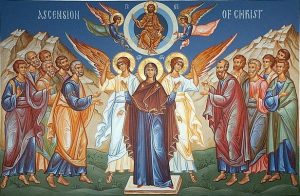Metropolitan Athanasios of Lemessos on the Ascension
On the fortieth day after his Resurrection, the Lord departed this world in the body and ascended into heaven, where he sits at the right hand of the Father. Naturally, this isn’t a specific place. That’s to say, there isn’t a seat next to the Father which Christ is sitting on. Nor is heaven a geographical region; it’s the realm where God is. Things were expressed in these terms so that we could understand that Christ departed and took with him our human nature when he ascended given that he was both God and human. As God, he was always with the Father and was never separated from him even for a moment. Both when he was on earth and when he was in Hades as God, as God he had the Father with him. The fact that he also took human nature with him is precisely the result of all that preceded: the passion, the cross, the grave and the resurrection. Christ’s human nature ascended with him, and with it ascended the whole of deified human nature. So this event of the Ascension, of our deification, is something which has to do with the whole of the human person. It’s the glorification of the human body. This is what shows how greatly God has honored us. The notion that within the Church and its teachings the human body is disdained and all we talk about is the spirit and virtues is simply wrong. Quite the opposite. It’s the Church and Orthodoxy which deal particularly with the glorification of the human body.
– Pemptousia website
**We are pleased to include writings from modern Monasteries from time to time as well as our traditional Elders**
